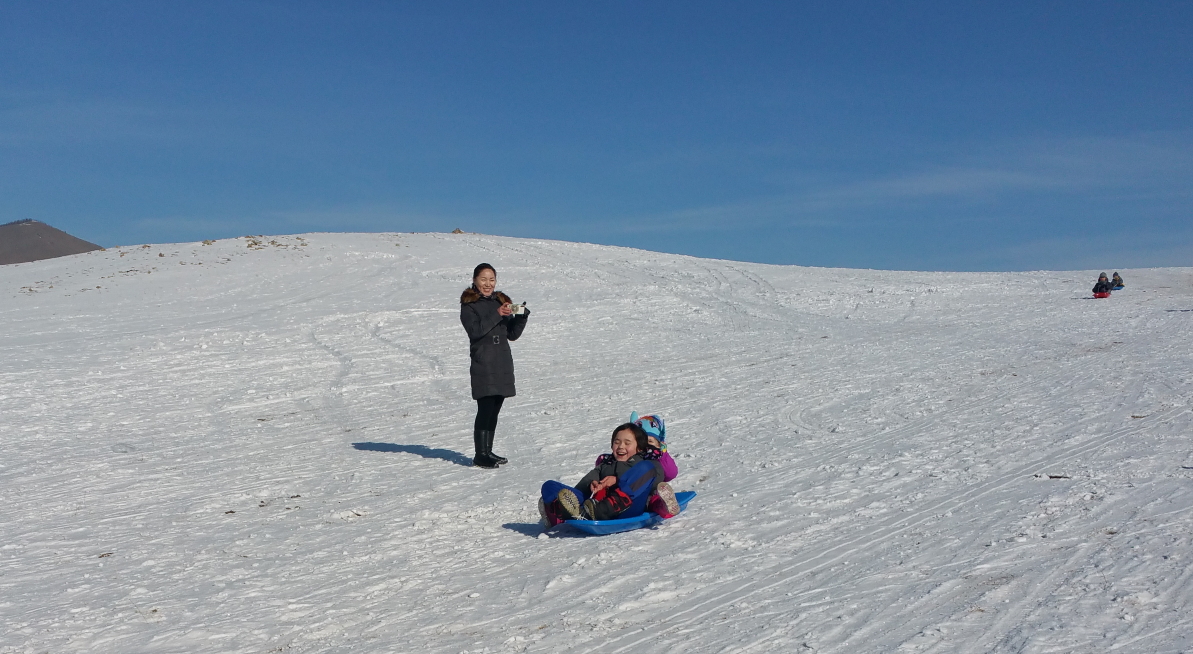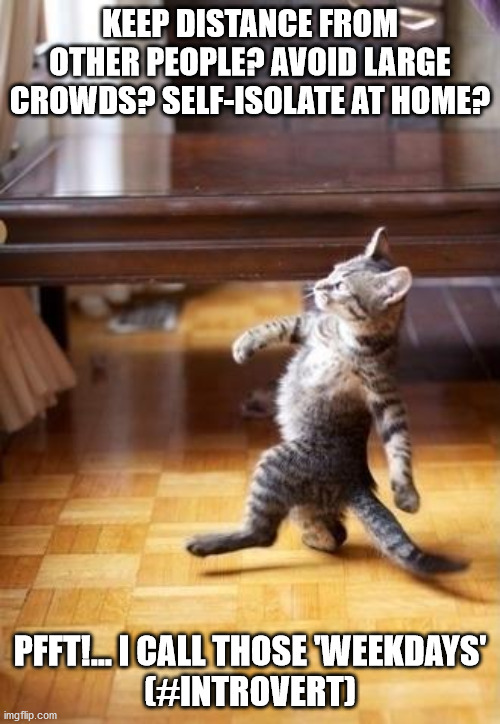
Every day I read about the state of the coronavirus pandemic in the USA, and every day my lack of faith in the US government grows even larger. My mother said she worries about us here in Mongolia, and wants us to waste no time in leaving and staying with them if things start to get bad here. While that is one of our contingency plans, the strange thing is that at this point we seem to be FAR better off here than in the USA… especially Washington state where my mother lives.
On the face of it, living in Mongolia has the following risks in the face of a coronavirus outbreak:
1) The health care infrastructure has improved over the years but is still substantially behind the US standard of health care (the standard for those Americans with good insurance anyway)
2) The average Mongolian does not have a high level of awareness about the spread of infectious disease or the dynamics of an outbreak. The average American may not know much about the dynamics of a pandemic, but they are a lot more germ-conscious (some might say germ-phobic) in general.
3) The Mongolian government does not have anywhere close to the resources the US has to respond to an outbreak like this.
4) Proximity to and sharing a border with China.
So as of March 9th, nine countries (including heavyweights like Germany, Italy, France, & the US) have more than 500 reported cases and in most of these nations the cases are growing exponentially. Yet despite its disadvantages, Mongolia has none. Why is that?
What the Mongolian Government Did
It is my opinion that the PRIMARY reason for this is that Mongolia’s government took it very seriously from the start and acted quickly. Before the end of January, Mongolia had stopped all regular flights to & from China and closed the China land border to car & pedestrian traffic, as well as closing all schools, universities, kindergartens, movie theaters, video arcades, and other large public entertainment venues. In the weeks that followed, they stopped all flights for South Korea, Japan, and Thailand, and placed special restrictions on those who’d been in any of those countries as well as Italy or Iran in the past 2 weeks (in those cases, foreign travelers are refused entry and Mongolians are allowed in but have a mandatory 2-week quarantine). They’ve also extended the existing school & public entertainment venue closures, instituted operating hour restrictions on restaurants & bars, and required face masks for anyone entering government buildings (many businesses have adopted that rule too).
The government here also appears to be acting quickly on the suspected cases that have popped up over the past several weeks. My wife works at one of the local private hospitals, and last month one of the patients they admitted the previous day had developed a fever, had been in South Korea recently, and tested negative for two of the common influenza strains. The government immediately closed the hospital to the public, brought the patient and the caregiver to their isolation center, and tracked down anyone in the hospital who may have had contact with them. Thankfully the next morning the tests for coronavirus came back negative and the hospital was soon re-opened.
Now I have to qualify all this in that it is easily possible that a few of Mongolia’s suspected cases actually turned up positive, and the government is keeping it under wraps for political reasons. But whether true or not, it still appears that there has been no sustained outbreak so far. They might be able to hide a few cases, but a community outbreak? Not bloody likely. Mongolia isn’t a technocratic police state like their southern neighbor, and the government here simply doesn’t have the means to pull it off.
What the US Government Did
Now contrast that to the response by the US federal government through January & February? The government and media response in that period is pretty much summed up by, “Oh, it’s a China problem” followed by “it’s nothing compared to the seasonal flu”, “don’t worry we have it all under control”, and “wearing masks doesn’t help anyway”. All of which turned out to be complete and utter horse****. And to top it off, they’ve been instituting such restrictive criteria to qualify for testing that many cases are likely going unreported. And while I know the screw-up with their initial batch of testing kits left them unusable, that doesn’t explain why they didn’t source some from Japan or elsewhere in the meantime? If a minor country (in the economic & geopolitical sense) like Mongolia could get their hands on testing kits from Japan, why couldn’t the US?
So this is how the government of the richest nation in the world has been handling the most important health crisis of the past decade, if not the past century? And as a result more lives will be lost and more damage will be done to the economy? I know many are tempted to blame Trump for all of it, and apart from shutting down US-China flights I would agree he’s handled this terribly so far. But while I think he deserves some blame, I honestly see the dysfunction as more systemic. In general, politicians and government officials from the top down tend to be too entwined with corporate interests or too interested in their re-election or avoiding controversy to do anything that would cause a burp in the local economy. It appears some of the European governments have shown almost as much ineptitude and indecision in the run-up to this pandemic, and it’s my opinion that it’s because they share the same lack of spine necessary to risk short-term impacts to their economies.
Worse Than a Clown-Show
Now in all fairness, I have to say that, in most things, Mongolia’s government is a total clown-show. There’s no shortage of Parliament members wetting their beak in crooked deals, embezzlement by officials, and other shady nonsense. This is NOT the shining example of a government by and for the people. Yet this questionable government of an economically tiny country is absolutely DUNKING on the United States. It is a f***ing embarrassment. If Mongolia’s government is a clown-show, then the US government is the monkey at the zoo that flings its poo at the visitors.
Where To Go From Here?
As fun as it is to criticize, it would be lame to not offer some solutions or ideas on what to do going forward. Not that I expect anyone in power would have me anywhere on their radar, but just maybe one of these suggestions will somehow make it’s way to decision makers in some county, state, or D.C. office:
1) Set up drive-thru testing areas (like the ones they have in South Korea) for the public in all the major affected areas as well as all large metro areas not yet affected. Many like me are not at high risk of serious hospitalization or death from the virus, but we can still spread it to others who ARE more vulnerable. Help us get the information we need to protect our friends and loved ones. If the gov’t stocks of testing kits are insufficient, order more from Japan or wherever else they’re available. Let’s not be snobbish about “Made in America” for this sort of thing.
2) Use some of that money in the recently-passed coronavirus emergency spending bill to cover ALL costs of testing and treatment related to the coronavirus pandemic. How many people are afraid to get tested or treated because of lack of insurance or money? I’m not in favor of socialized medicine as a permanent system, but there’s a place for government funds when it comes to public health emergencies. It’s one of the few arguments for having a central government authority that I agree have some merit.
3) Send calls out for appropriately-located hotels and resorts to house infected individuals that need to be isolated but aren’t sick enough to need hospital care. The secondary economic effects of this pandemic are going to hit the hospitality industry HARD, and renting out their facilities to help in this crisis can help them avoid bankruptcy. Dave Collum on Twitter suggested (with a bit of irony) using cruise ships for this. Despite the irony, it might not be the worst idea. Cruise lines are probably going to get hit just as hard as hotels (if not harder), and you gotta admit it’s more of a challenge for people to sneak out of a quarantined cruise ship. Even one that’s docked.
4) Stop this dishonest talking point that “masks aren’t helpful for the public”. I strongly suspect what they REALLY mean is “we screwed up and didn’t source and stockpile enough masks, even WITH several weeks of warning coming from China”. Just admit that for now there’s only enough for medical professionals, but producers are working to make more available to the public in the near future. You say too many people don’t know how to properly wear or handle masks? Well then TEACH them… it takes like two friggin’ minutes (like this instructional video here). While N95 masks are intended to protect the wearer to some degree, the truth about surgical masks is that they’re more about protecting others from YOUR germs than protecting you from THEIRS. So there IS value in having a majority of the population wearing surgical masks when out of the house. A community effort here can make a difference.
5) Implement REAL travel restrictions for Italy, South Korea, and anywhere else that has a very large OR uncontrolled outbreak. None of this ‘travel advisory’ crap. I’m talking _”if you’ve been to any of these places in the past 14 days you will go into mandatory quarantine for 2 weeks or will NOT enter the country”_. We do this for those who’ve been in China, and to not do it for other areas hit hard it is not only hypocritical but unnecessarily dangerous.
Screw-ups or not, this is not the end of the world. The recent mistakes have cost the US and other countries valuable time in stemming the spread of this pandemic, but there are still things we can do going forward. If you want to be better informed, Dr. Chris Martenson at Peak Prosperity has been giving excellent videos and articles that you can find here or on YouTube. The facts & information he provides can be sobering, but he does an excellent job citing sources and stating which information is proven and which is conjecture.
In the meantime, let’s hope the US government gets its act together and catches up to Mongolia’s level of minimal competence. The government decision-makers better hope so too. Because if they don’t, they might just find themselves getting replaced with something new…

So, it seems like those in the US and Europe are really waking up to the coronavirus pandemic, with panic buying starting to be seen at Costcos and certain items flying off the shelves. In the spirit of giving you folks a heads up of other things that might come (and hopefully allay some of the panic), here are some observations I’ve made in Mongolia where we’ve been 5 or 6 weeks ahead of most of you in this pandemic.
1) Panic buying
Buying panics have happened twice here in Ulaanbaatar. The first time was in late January before we arrived back, and apparently it got started when someone posted some empty shelves at a store on Facebook. A lot of people hit the stores and emptied the shelves, but the stores had almost everything restocked within a few days. The second time was a few weeks later when someone on Facebook claimed that a suspected case in Khuvsgul died and his family was in quarantine (the gov’t said it was ‘fake news’ and fined the poster… hard to say if it was gov’t coverup or not). Again, stores were back to normal within a couple days easy.
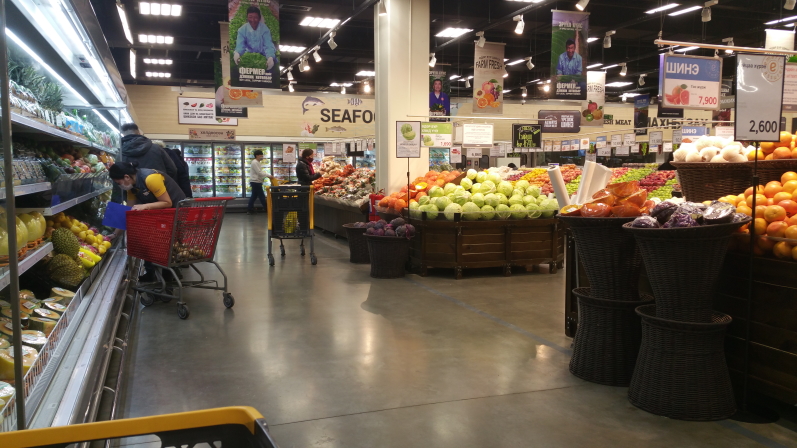
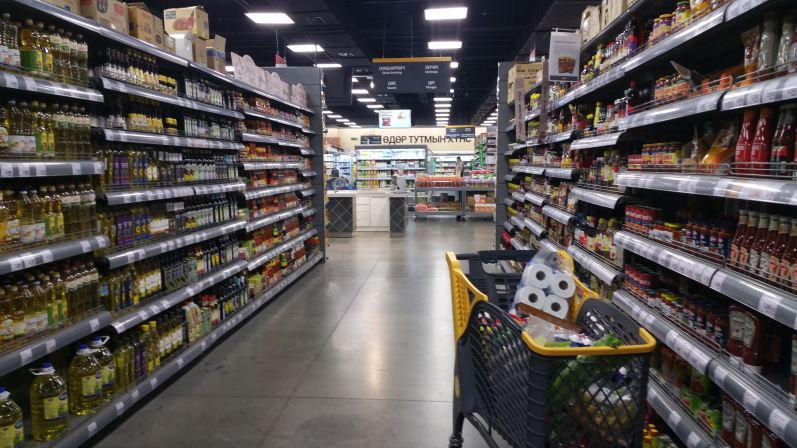
Our local E-mart grocery supermarket the week after the first panic buying event. Everything more or less normal.
To be fair every situation will be somewhat different, but I would expect most stores will be mostly restocked within a week of being hit by panic-buyers. Our experience was not that shelves are stripped bare (at least not for longer than a few days), but rather we simply end up with a handful of certain products that sell out and stay sold out like N95 & surgical masks, hand sanitizer, Clorox wipes, and Theraflu. But most of the basics… soap, canned & perishable foods, toilet paper can still be found anywhere. To be fair there might be certain items that aren’t impossible to find but tend to sell out quickly. Here liquid bleach has been one of those things. And while we haven’t seen it here, I heard that “runs” on toilet paper were big in Singapore… (sorry, couldn’t resist 
2) School closures
The schools and universities here have been closed for something like five weeks now, and instead they’re broadcasting classes for each grade level through the day. The ‘classes’ are less than an hour so it’s a poor substitute, but it’s something. We had been doing some homeschooling on the side with online resources and some workbooks for a few years now, and since the schools were closed we’ve been putting more emphasis on those lately.
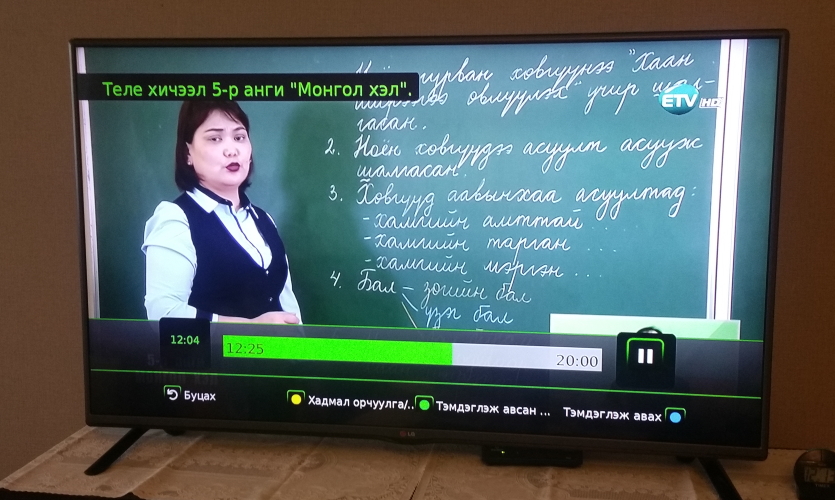
My son’s televised class for the day.
I think it’s reasonable to expect some areas in North America and Europe will be closing their schools in response to the pandemic. So for you parents of school-age children, are you ready for that? If not, look into finding ways to ensure your kids have someone to watch them during the day and buy (or at least be ready to buy) some additional learning workbooks and such.
3) Business closures
With the school closures here came closures of other businesses that pose high risk of spreading infections. These include kindergartens & daycare centers, movie theaters, concerts & large public entertainment venues, and gyms & fitness centers. As you can imagine, businesses reliant on cross-border trade & tourism are effectively being shut down from border closures too. Restaurants are still open, but both restaurants and bars have been ordered to reduce their hours.
So now we’ve got a lot of people working in these areas that are either working less or temporarily out of a job… teachers, restaurant workers, fitness instructors, you name it. Those people are spending a lot less now, and that combined with everyone else going out of the house less is negatively impacting other businesses like restaurants, shops, street vendors, and taxi drivers. Hopefully your neck of the woods won’t see this level of impact, but it’s something you should be prepared for. If you work in these sectors or have a business reliant on them, prepare your cash reserves and make a plan now just in case.
4) Travel restrictions
The first travel restrictions we experienced were air and land traffic closures from China, and shortly afterwards it was expanded to Hong Kong and Taiwan. As cases spread in Japan, South Korea, and Italy we had restrictions on people traveling from those places as well. Interestingly Bangkok is in the list too despite the low ‘official’ number of cases in Thailand (obviously there is distrust in the official numbers). Recently the US State Department issued a travel advisory for Mongolia… not so much because of infection risk, but mostly because so many of the air & land travel routes in & out of Mongolia have been shut down. The only routes remaining are through Moscow and Istanbul, and I won’t be surprised if the Istanbul route is closed in the next month too. Leaving may soon get to be very difficult.
Inside the country, recently we had the roads between the Mongolian provinces and the roads in & out of the capital closed for a time, and the government even extended that closure to March 3rd, five days past their original re-opening date. When they re-open they’re going to be doing temperature checks and questionnaires of all cars going in and out of the capital. While the flight restrictions out of the country haven’t affected us (we weren’t planning to travel again for many months), the in-country travel restrictions have been a pain in the butt. We were hoping to bring our kids out to stay at their grandparents’ house in the countryside late last week, but the extended road closures in & out of the city have put a crimp on that plan. While not a calamity, it is a major inconvenience.
What Would I Do?
So having experienced all this, what would I be doing if I were still in the US? Well, I definitely wouldn’t be in those long lines at Costco. But pretending I was an average joe, these are what would I focus on:
- I’d have at least three weeks of food and household consumables in the house. This is something most people should have already, but sadly the average joe usually does not. I can tell you I would NOT be buying a crap-ton of freeze-dried survival food and bottled water. There’s a place for that sort of thing, but it’s hardly a priority in this scenario. Instead I’d make a list and buy a mix of canned & frozen & refrigerated foods from anyplace that does NOT have lines out the door. This is not a hurricane folks; it’s a pandemic of a concerning (but not highly lethal) virus. Odds are the water and electricity will still be working the whole time. Having a gravity filter like a Big Berkey makes sense, but a truckload of bottled water? Not so much.
- I’d make sure I was stocked up on maybe six weeks’ worth of basic health, hygiene, and sanitary supplies. Things like soap, shampoo, dish soap, laundry detergent, and especially bleach. I’d certainly pick up some N95 masks, surgical masks, Clorox wipes, and hand sanitizer if there was any available at close to normal price, but I wouldn’t fill my cart with them. Buying up such things in bulk BEFORE a disaster is sensible planning, but doing so DURING a disaster is irresponsible. In the unlikely event you see a good amount of such available, set an example and leave enough for others to buy. And I would NOT buy any masks, hand sanitizer, etc., at some of the extreme prices some are charging online. You’re probably better off saving that money to prepare for reduced hours or a temporary job loss or absence from work.
- I would make sure I have at least two months of any prescription medications my family depends on. I’m not in this situation myself thankfully, but I know many others are.
- I would make preparations and contingencies for schools being closed and our kids staying at home during the day. Not only for someone trustworthy to watch them during the day, but to have supplementary learning materials on-hand for them during their absence from school.
- I’d be saving as much money as possible to prepare for weeks or months without being able to work. I see the odds one will be impacted by a layoff or be sick and out of work for a month from this whole thing are far higher than my chances of being hospitalized by the coronavirus (which currently seems to be just under 20%, and substantially less if not elderly and not having a pre-existing health condition).
- I would keep a fair amount of cash reserved in my trading and retirement accounts (this is in fact what I’m doing right now). The current market plunge I think represents a good buying opportunity, and while I personally think there’s more of a market drop to come I AM looking for opportunities to get back into the market. But as Scott Adams of ‘Dilbert’ fame says, never take financial advice from cartoonists. So do your own homework on this one.
- I would be updating my resume, and if I thought my job would be at high risk due to supply chain disruptions or closures of business sectors I would be actively job-hunting or otherwise arranging to make some replacement or supplemental income. Both of my primary revenue streams, cryptocurrency mining and content creation, are things that aren’t highly vulnerable to coronavirus economic repercussions and they don’t require me to leave the house. But if I had a regular job, you better believe I’d be updating my resume and exploring some less conventional options!
- I would take into consideration my location and those people who depend on me and act accordingly. If it means I easily could be cut off from them, I might have them stay with me for a while or make whatever arrangement so I could continue to care for them.
- If it was just me living alone and being in good health, I’d probably make a point to go out of the house less often but wouldn’t take it to an extreme. If I had a spouse & kids, I’d limit my time outside the house to just necessary work commitments and runs to the grocery store (and if there was a local outbreak I’d pull my kids from school… if the school administrators complained I’d tell them to piss off). In the event I had someone in my household who was elderly or had major existing health conditions, if there was a local outbreak I’d either find a way to work from home or find a way to keep said house-member separated from me and anyone else who has to go outside the house regularly.
Anyway, please remember this isn’t the end of the world. It may be rough for a time, in some areas of the world a lot more than others, but the vast majority of us will get through this just fine. The biggest danger of this is not so much the coronavirus, but in how some people and governments will react to it. There will be both difficulties and opportunities in the months to come. Keep your head and don’t lose perspective, and you just might come out of this not only unscathed but in a better financial position than you are now…
The Mongolian Lunar New Year, referred to locally as Tsagaan Sar, just started today on Monday Feb 24th. This holiday is typically celebrated by preparing large amounts of food and feasting & drinking over a few days. Think of Thanksgiving or Christmas dinner, but extended over at least three days and a heavier emphasis on drinking (predominantly vodka but beer is common too). A given family will typically host a number of other visiting groups of relatives and friends to their home (each group typically visiting for at least an hour or so), and they in turn will spend part of the holiday visiting those other families at their homes.

A prime example of a Tsaagan Sar food setup.
With so many people traveling around and sharing food in close proximity, it’s a nightmare from an epidemic containment perspective. Thus the holiday celebration has been ‘cancelled’ by the Mongolian government. In truth, it’s not doing away with the entire holiday but rather the ‘celebration’ of it in terms of public gatherings, traveling, or hosting other families. People with regular jobs are still getting Monday through Wednesday off, but we’re all expected to do no traveling and observe the holiday by staying at home.
Now Mongolians on average don’t have a lot of respect for what the government proclaims, and often just go on doing their own thing. It’s usually one of their more endearing qualities, in my humble opinion. But in this specific situation it’s creating unnecessary risk. The Mongolian government is painfully aware that a proclamation alone will be mostly ignored, so from Feb 23-26 they’ve closed ALL the roads in and out of the capital (Ulaanbaatar) and the roads between the various provinces (Aimags). Additionally, they shut down all public transportation services in the capital from Feb 24-26. The day before the shutdown we drove out to pick up our kids at their grandparents’ house in the countryside, and the police already established the checkpoint where the road will be closed. They weren’t yet blocking traffic, but they WERE using handheld temperature scanners to scan all vehicle occupants leaving the city. Interestingly, they didn’t scan us on the way back into the city. My guess is they have a shortage of scanners and at some point just had to let cars through to avoid an epic traffic jam.
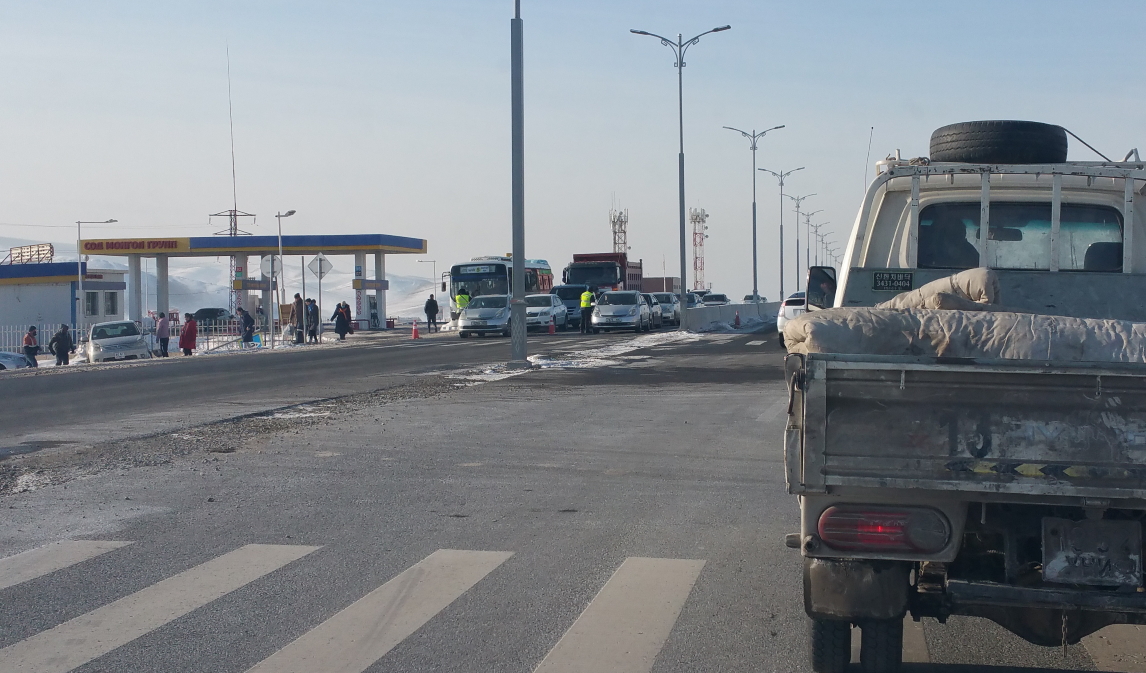
One of the temperature scanning checkpoints going in and out of the capital.
Such a thing is a little hard to imagine for most people from Western Europe, Australia, North America, etc., but it’s a reality here now. Being from Alaska I’m accustomed to major roads occasionally being closed due to weather or natural disaster, but this is the first time I’ve been in a place where it’s been done by government action. On a pragmatic level I have no problem with such temporary restrictions put in place in this specific situation, and I think it’s an intelligent move on the part of the Mongolian government. But it doesn’t change my discomfort with the situation. I wasn’t planning to leave town anyway, but I like having the option.
Now will this work to keep Mongolians from visiting other families during the holiday? At this point it looks like it will reduce the number of visits somewhat but will be lucky if it cuts it even by half. Those in the city may not be traveling out of town, but they’ll still visit other families in town. The parking lot outside my apartment is packed with more cars than normal, so if that’s any indicator I’d say only some are staying home. Public transportation may be shut down, but as far as I know all the roads within the city are still open. Though I wouldn’t be surprised if police are doing random stops to do temperature scans of drivers and passengers.
Those in the country are even less likely to observe the restriction, partly due to less familiarity with the nature of pandemics and partly because the ‘roads’ are often any number of dirt paths criss-crossing the countryside. “Closing the roads” is not terribly effective when much of the terrain is steppe and half the population doesn’t usually drive on pavement much anyway.

As you can see, many ‘roads’ in Mongolia are not a simple affair to close…
My wife’s opinion is the Mongolians in the countryside won’t observe the restriction at all. What makes this even more dangerous for them is that most people in the countryside don’t have running water and thus dishes & silverware often don’t get cleaned as thoroughly between uses. Additionally most live in gers (or “yurts” as most commonly know them) or small houses, and those close quarters make spreading infection even more likely.
Will this result in COVID-19 spreading in Mongolia? If I were forced to guess, I’d say the odds are it won’t because there aren’t any known outbreaks in any communities here yet (keeping fingers crossed). But it’s still taking an unnecessary risk, and people here need to establish the habits that will reduce any future spread of this flu. This isn’t the Zombie-Mutant-Biker-Apocalypse kind of flu that some alternative-media shills are hinting at, and I also suspect for the average person the odds of catching the virus are FAR less than the odds of feeling some pain from COVID-19’s economic fallout (interrupted supply chains, people staying at home more often, etc). But it’s certainly a much bigger deal than the seasonal flu, and reducing the spread even a little bit means a little less pain on everyone as a whole. That’s why our family is staying home this holiday… not because the government says so. In fact whenever a government and I are in agreement on something, I sometimes take it as a reason to re-examine my line of thinking. Not this time, but sometimes…
Local COVID-19 news:
– Mongolian airline MIAT cancels flights to Tokyo and Bangkok. Also a Mongolian language article mentioning the government suspending ALL flights (not just MIAT airlines) to and from South Korea until March 2nd. Funny to think that China, South Korea, and Iran are suffering travel restrictions because of outbreaks in their own country, but in Mongolia we’re seeing travel restrictions because most of the direct flights in & out are WITH said countries. At this point I believe the only flights going in and out are through Moscow.
– Mongolia extends quarantine period until 1 April. In other words, schools remain closed until April 1st (and for students there was much rejoicing!).
– Mongolia denies entry for 15 suspected people. Except for one Chinese citizen who flew via the capital’s airport in Ulaanbaatar, most of these appear to be Mongolians trying to get back into Mongolia via the land border. At this point I’m guessing they’ll have to wait until Mongolia charters special transportation to take them back and straight into quarantine.
As of this writing, there are no confirmed cases of the novel coronavirus, or COVID-19, in Mongolia. But given the shared border with China and local government actions, it’s still having an impact here. This travel post is a quick overview of the current situation in Mongolia in the emergence of the neighboring pandemic.
No Officially Confirmed Cases, But Many in Quarantine
Even with no officially confirmed cases here, it’s quite possible there are infected persons currently in quarantine. There are hundreds currently under quarantine, almost all of them Mongolians brought back from China on special flights and buses. The earliest ones that were flown in from Wuhan were recently cleared from their 2-week quarantine, but many others remain under quarantine. In fact the news today mentioned three buses had just brought in 104 Mongolians who were stuck in China’s Inner Mongolia province, and after medical examinations one of the passengers is suspected of having COVID-19. I personally suspect some of these cases ARE confirmed with testing, but the Mongolian government doesn’t want it getting out yet for fear of border closures with Russia and further interruption in trade.
Speaking of word getting out, last week there was a report of one suspected infection in Khuvsgul province, and a couple days later someone on Facebook made a post that this person died of COVID-19 and the person’s family was in quarantine. The government response was… interesting. They announced they were fining said person and some others two million Tugriks (~$750) for creating or spreading ‘fake news’, but said little else. While it’s certainly possible the information was false, the total lack of information being released and the way the government is avoiding any direct mention of the case is suspicious to say the least.
Border Closure and Obstacles in the Flow of Imports & Exports
One of the largest changes here is the Mongolian government’s decision to shut down all passenger air and land crossings from China, except for special buses and flights carrying Mongolians stuck in China into Mongolia (said passengers going straight into quarantine). They even stopped coal deliveries into China almost a week ago after some of the coal truck drivers were suspected of having symptoms. Given that Mongolia’s main export partner is China and coal is a big part of that, economically speaking it’s a big deal. For the time being goods are still being imported from and through China by railway. Most of Mongolia’s imports come from or through China, so if that stops then we will know things are real serious. As it is, with much of China’s industrial and agricultural base still shut down or operating at reduced levels we already see shortages of random things.
The most notable of these shortages I heard was with a certain chemical Mongolian companies use to make the processed coal briquettes that have been replacing raw coal for heating stoves. Apparently the chemical in question was being sourced from China, and that source was no longer available (the extended shutdown in production being implied as the cause). They’re currently trying to find alternate sources, but if they can’t then the city residents won’t have any choice but to (illegally) burn raw coal instead. The wintertime pollution in the capital has significantly improved since the switch from raw coal, but if the briquettes run out then the coal smoke pollution will come back with a vengeance. It’s a good example of how reliant the world is on international supply chains.
Closures of Schools, Universities, and Public Entertainment Venues
In daily life, probably the biggest change here is the closure of all schools, universities, and kindergartens. In addition, they’ve also closed certain public entertainment venues such as concerts, movie theaters, and video arcades. Initially the closure was to be for about one month and re-open on March 2nd, but recently they extended that to March 31st. As you can imagine, many children (including my own) are totally heartbroken about the schools closing…
These may seem like extreme measures for a country that has no confirmed cases and has already shut down regular border crossings from China, but there are two factors at play that justifies it. The first is Mongolia’s medical care infrastructure is under-prepared for an epidemic. To be fair ALL nations are under-prepared for major pandemics, but on the spectrum of preparedness Mongolia has less resources than most developed nations. The second is that Mongolians (and their government) have zero trust in China’s government, and is assuming things are much worse than they’re letting on. It pains me to say nice things about ANY government, but I gotta say Mongolia’s government in this case is being remarkably forward-thinking and proactive in the face of the potential economic & social backlash. What can I say, I hate government but I still have to give credit where credit is due.
Public Sentiment in Mongolia
As for the public sentiment on the neighboring outbreak, I’d say it’s best described as ‘concerned and cautious’ along with ‘wait and see’. The COVID-19 outbreak is taking up a large section of the TV news each night, and the reporters are even wearing masks as they report the news (I assume it’s more for the sake of promoting the wearing of masks than protecting themselves). But aside from that, more people wearing masks in public, and the closure of the schools, it’s not a whole lot different from before. People are still going to work, still going shopping (though maybe with more emphasis on stocking up on essentials), and still going about their lives. It has required adjustments, like with going out a little less and having kids staying at home watching televised classes instead of being at school. But life is still going on and I’m not seeing any overwhelming mood of fear. Heck, just last week we took the kids and their cousins sledding and they had a blast!
Be Cautious, But Don’t Live in Fear
My own take on COVID-19 is that it’s worth taking very seriously (certainly more so than those likening this to just a bad seasonal flu) and it will likely bring on a lot of pain, but it won’t be the end of the world. Take some practical precautions like using face masks, washing one’s hands diligently, and saving money to prepare for potential extended absences from work. But it’s no reason to live in fear… life without fun is no life at all!
